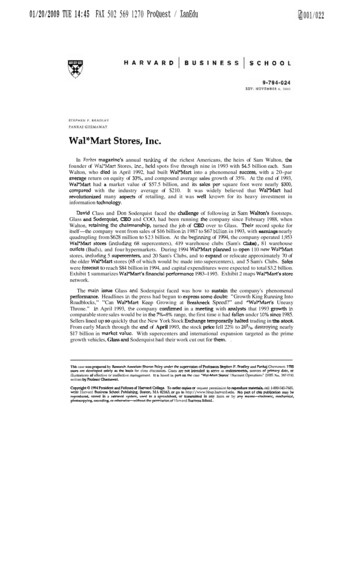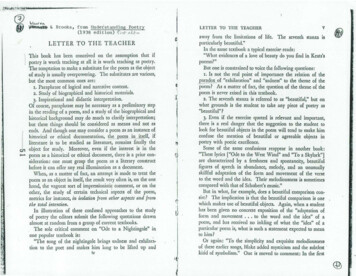
Transcription
01/2012009 TUE 14:45 PA1. 502 569 1270 ProQuest 1 XanEduWa1"Mart Stores, Inc.In Forbes magazine's annual ranking of the richest Americans, the heirs of Sam Walton, thefounder of Wal'Mart Stores, h.held, spots five through nine in 1993 with 9.5 billion each. SamWalton, who died in April 1992, had built Wal*Mart into a phenomenal s u c c with,a 20-paravenge return on equity of 3376, and compound average s a l e growth of 35%. At the end of 1993,WalSMart had a market value of 57.5 billion, and its sales pcr square foot were nearly ROO,compard with the industry average of 210. It was widely believed that WalDMart hadrevolutionized many aspedv of retailing, and it was wcll known for its heavy investment ininformation technology.David Class and Don Soderquist faced the M e r g e of following in Sam Walton's footsteps.Glass and SoderquLt, CEO and COO, had been running thc company since February 1988, whenWalton, retaining tlic chairmanship, turned the job of CEO over to Glass. Their record spoke foritself-the company went from sales of 16 billion in 1987 to 67 billion in 1993, with earnings nearlyquadrupling from 628 million to 23 billion. At the beginning of 1994, the company operated 1,953Wal*Mart stores (mduding 68 supercenters), 419 warehouse clubs (Sam's Clubs), 81 warehouseoutlcts (Bud's), and four hypermarkets. During 1994 WaleMart p l m e d to open 110 new WalDMxtstores, including 5 suprcenters, and 20 Sam's Clubs, and to expand or relocate approximately 70 ofthe older Wal*Mart stores (6of which would bc made into supercenters), and 5 Sam's Clubs. Salcswere forecast to reach 84 billion in 1994, and capital expenditures were expected to total 3.2 billion.Exhibit I summarizes WalDMart'sfinallcia1 pcrformancc 1983-1 993. Exhibit 2 maps WaleMart's storcnetwork.The main issue Glass and Soderquist faced was how to swtain the company's phenomenalperfomlance. Headlines in the press had begun to express somc doubk "Growth King Running IntoRoadblocks," "Can WalDMart Keep Growing at Breakneck Speed?" and "Wal*MartJs UneasyThrone." h April 1993, the company confirmed in a meeting with analysts that 1993 growth incomparable store sales would be in t l 7%-8%crange, the first time it had fallcn undcr 10% sincc 1985.Sellers lined up so quickly that the New York Stock Exd angetemporarily halted trading in the stock.From early March through the m d of April 1993, the stock price fell 22% to 2G5/#. destcoying nearly 17 billion in markct valuc. With supercenters and international expansion targeted as the primegrowth vehicles, Glass and Soderquist had their work cut out for theni. .This caw was prcprcd by Research Acuciate Shamn Tnlcy undcr Ik supervision of Profmrs m h c n P. nndlry and Fanlwj Ghrm.awnt. ImSam arr drwlopd solely JS IhC basis for claw disms im. Cam m nol intcndcd to scrvc as m d o m l s , 601nf primary dst?, oriUu9bat11nwof eff&ivt? O? in&Yive lMMgmrnt It in h a d in p r t on thr caw "WaI-MartStor-' l#munt *atinn%*0-1115 No. .W7fllS)wdllnl by Profesor Ghemnwnt.Copynsht O 1994 Prcsidcnt and Fellows of H n r v dCoUege. To ordu ooplcs or 9 - 1 pm&ion lo reproduce mteriak, call 143XW-76%.writc 1,Iarvxci Oasincs School hblishing, :,ton,MA 02163, or go to h t t p : / / . h l p h r n r d e dpmlu of chis publicntim may lwNorrprduccd, ntond in a rrh-iernl sptem, u . 4 in a sprrgdshmt, or hansmittcd in any form or by sny m r a n s - d m i r , rncchsnical,photwopyins recordin& nr othmwkewithout thr r m i s i o fn 1,lawordUusims School.
01/20/2009 T I E 14:46 FAX 502 569 1270ProQuest / XanEduWal'Mart Stores, Inc.Discourit RetdingDiscount stores emerged in the United States in the mid-1950.; on the heels of supermarkets,which sold food at unprecedentedly low margins. Discount stores extend& this approach to generalmerchandise by charging gross margins 10"'-15% lower than those of conventional departmentstores. To compensate, discount stores cut costs to the bone: fixtures were distincdy unluxurious,in-store selling was limited, and ancillary scrviccs, such as delivery, and credit, were scarce.Thc discouiitcrs' timing was just right, as consumers had become increasingly better informedsince World War Ll. Supermarkets had educated them about self-service, many cakegorics of generalmcrchandisc had maturcd, and TV liad intcnsificd advertising by manufacturers. G o v e m e n tstandards had also bolstered consumers' self-confidence, and many wcrc rcady to try cheaper, selfscrvicc rctailcrs, cxccpt for products tlmt were big-ticket item, technologically complex, or"psychologically sigruticant."Discount retailing burgeoned as a result, and many players entered the industry at the local,regional, or national leveIs. Sales grew at a compound annual rate of 25% from 2 billion in 3960 to 19 billion in 1970. During the 1970s, tlic industry continued to grow at an annual rate of 9%, withthe number of new stores increasing 5% m u a l l y ; during the 1980s it grcw at a rate of 7%, but thenumbcr of storcs incrcascd by only 1%; and during the 1 9 9 0 it grew 11.2%, with the nurnber ofstDres increasing by nearly 2%. This trend toward fewer new store openings was attributed to a morecautious approach to expaiwion by discounters, who placed increasing emphasis on therefurbishment of existing stores. Ln 1993, discount industry sales wcrc 124 billion, and analystspredicted that thcy would increase about 5%annually over the next five year;.Of the top 10 discounters operating in 1962-the year Wal*Mart opened for business-not oneremained in 1993. Several large diseomt chcains,such as King's, Korvcttc's, Mammoth Mart, W.T.Grant, Two Guys, Wodco, and Zayre, failed over the years or were acquired by survivors. As aresdt, the industry k a m e more concentrat& whereas in 1986 the top 5 discounters had accountedfor 62% of industry sales, in 1993 they accounted for 7l%, and discount store companie that operated50 or more stores a c c m t e d for 82%. Exhibit 3 shows the top discountcrs in 1993.Wal*MartfsDiscount StoresHistoy of GrowthProviding value was a part of the Wal*Mart culture from the time Sam Wdton opened his firstBen Franklin franchise store in 1945. During the 1950s, tlic numbcr of Walton-owned Ben Franklinfranchises increased to 15. In 1962, after his idea for opening stores in small towns was turned downby the k n kanklin organization, S;un and his brother Bud opcncd thc first 'Wal*Mart Discount CityFor years, while he was buildingstore," with Sam putting up 95% of thc dollars himself.'WalLMartu,Walton continued to run his Den Franklin stores, gradually phasing them out by 1976.When Wal*Mart was incorporated on October 31, 1969, thcrc were 18 Wal Martstores, and 15 &nFranklins.By 1970, Walton had steadily expanded his chain to 30 discount stores in rural Arkansas,Missouri, and Oklahoma. Howwer, with continued rapid growth in the rural south and midwest,Two othcr Iiiv I U I E dC w ;otthcir s k r t in 1962; Kn rtarrl Target.
01/20/2009TUE 1 4 4 FA1 502 569 1270 ProQuest / XanEduWal*Naff Stom, Lc.the cost of goods s o l d - h o s t three-quarters of discounting revenues-nnklcd.As Walton put it,"Hcrc wc wcrc in the boondock, so we didn't have distributors falling over themselves to serve uslike competitors in larger towns. Our only alternative was to build our own warehouse so we couldbuy in volume at attractive prices and storc thc mcrchandjse."2 Since warchouxs cost 5 million ormore each, Walton took the company public in 1972 and raised 3.3 million.Thcrc wcrc two kcy aspects to Walton's plan for growing WalSMart. The first was locating storesin isolated rural areas and small towns, usually with populations of 5,000 to 25,000. Hc put it thisway: "Our key strategy was to put good-s5zed stores into little one-horse towns which everybodyelse was ignoring."3 Walton was convinced that discounting auld work in small towns: "Tf wcoffered prices as good or k t t c r than stores in citics that wcrc four hours away by car," he said,"pcoplc would shop at home.Ic4 The second element of Walton's plan was the pattern of expansion.As David Glass explained, 'We are always pushing from the inside out. Wc never jump and thenbackfill."sTn the mid-1980s. about onc-third of Wal*Mart stores were located in areas that were not savedby any of its competitor;. However, the company's geographic growth resultcd in increasedcompctition with other major retailers. By 1993, 55% of Wal*Mart stores faced direct competitionfrom h a r t stores, and 23% from Target, wlicrcas 82% of Kmart storcsand 8.5% of Target stores facedcompctition from Wal*Mart6 Wal*Mart penetrated the West Coast and northeastern states, and byearly 1994, operated in 47 states, with stores planned for Vermont,. Hawaii, and Alaska. Exhibit 4compares Wal*Martls performance with that of its competitors.Sam's L gacyWhen Sim Walton died in April of 1992 at the age of 74 after a long fight with canccr, hismemorial service was broadcast to evcry storc over thc company's satellite system. Walton had aphilosophy that drove everything in the busintfss; he believed in the value of the dollar and wasobsessed with keeping prices bellow wcrybody dsc's. On buying trips, his rule of thumb was thattrip expenses should not exceed 1% of the purchases, which meant sharing hotel rooms and walkinginskcad of taking taxis.Walton instilled in his cmployccs (called associates) the idea that Wal*Mart had ib own way ofdoing things, and hied to make life at the company unpredictable, interesting, and fun. Hc evendanced thc hula on Wall Strcct in askirt after losing a bet to David Glass, who had predictedthat the company's pretax profit would be more than 8% in 19%. Walton said, "Most folks probablythought we just had a wacky chairman who was pulling a pretty primitive publicity stunt. What theydidn't realize is that this sort of stuff goes on a11 the time at Wal'Matt.'vWalton spent as much time as possible in his own stotw and c l i k i n gout the competition Hewas knowti to count the number of cars in Kmart and Target parking lots, and tapmeasure shelfS.un Wdton with JohnHucy, Sam WuTtun,Mude in Anirm' ? (New Y f k Bafttam:Bwk, 1992).Huincss Week, November 5, 1979, p. 145.('George C. Svnclian, "The State nf the Diwount Stare Industry."G l d m Sachs. April 6,lW.
WaPMart Stores, h c .space and note sale prices at Ames. Walton knew his competitors intimately and copied their bestideas. He got to know Sol Pricc, who crca tcd Price Club, and then redid the eoncept as Sam's Club.To Walt-on, tlic most important ingredient in WaI*Mart's success was the way it treated itsassociates. He believed that if you wanted the people ia the stores to take carc of the customers, youhad to make sure that you were taking a r c of thc pcople in the stows. There was one aspect of theWal*Mart culture that bothered Walton from the time WalwMartbecame really succcsshl. 'We'vehad lots and lots of millionaires in our ranks," he said, "and it just drives me crazy when they flaunti t Every now and then samebody will do something particularly showy, and I don't hesitate to rant andrave about it at the Saturday morning meeting- I don't think that big -ionsand flashy carsare what the Wal*Mart culture is supposed to be about-wing the customer."*Walton dcscribcd his management style as "management by walking and flying around." Othcrsat Wal'Mnrt described it as "management by wearing you down" and "management by looking overyour shoulder." On managing people, Walton said, "You've got to give folks responsibility, you'vegot to trust them, and then you've got to chcck up on them." Wal*Mart's parmetship with itsassociates meant sharing the numbers--Walton ran the business as an open book and maintained anopen-door policy. Wa14Mart aimcd to cxccl by empowering associates, maint ajnjngtechnologicalsuperiority, and building loyalty among associates, customers, and suppliers.WaluMart mercliandisc was tailored to individual markeb and, in m a y cases, to individualstores. Information systems made this possible through "traiting," a process which indexed productmovements in the store to ovcr a tliousand storc and market traits. The local store m mager,usinginventory and sales data, chose which products to displily based on customcr preferences, andallocated shelf space for a product catcgory according to the demand at hi or her store. Wal*Martlspromotional strategy of "everyday-low-prices"meant offering customers brand name merchandisefor less than department and specialty storc prices. Wal*Mart had few promotions. While othermajor competitory typically ran 50 to 100 advertised circulars annually to build traffic, Wa16Martoffered 13 major circulars pcr ycar. In 1993, Wal*Martls advertising expense was 1.5% of discountstorc salcs, compared to 2.1% for direct corn petit or . ln addition, WalwMartoffered a "satisfactionguaranteed" policy, whch meant that mercharldisc could bc rcLurncd to any WalSMartstore with noquestions asked.WalSMart was very competitive in terms of prices, and gave its store managers more latitude insetting prices than did "centrally priced" chains such as Caldor and Venture. Store managers priccdproducts to meet local market conditions, in order to maximize sales volumc and inventory turnover,while minimizing expenses. A study in the mid-1980s found that when Wal*Mart and Kmart werelocated next to each other, Wal*Martfs prices were roughly 1% lowcr, and when WalSMart, Kmart,and Target were separated by &6 miles, WalSMart's average prices were 10.4% and 7.6% lower,respectively. In remote locations, where Wal*Mart had no dircct competition from large discounters,its prices were 6% higher t h at locations where it was next to a Kmart.Co l pctitivechanges in discount retailing were reflected in WalwMart's decision to change itsmarketing slogan from "Always the low price-Always," (which WaPMart had used when buildingits chain by offering better prices than small-town merchants), to "Always low prices--Always." (See"bid.Management Ventures, hc.
U1/20/2009 TVE 14:47 FAI 502 569 1270 ProQuest / XanEduWalwMartStores, TneExhibit 5 for a pricing study between W&kartI Kraart, and Bradlees in suburban New Jcrscy.) Bythe ently 199% there was, typically, a 2%4% pricing differential between WaPMart and its bestcompetitors in most markets: h seven ptithg s'urveys conducted between 1992-1993, Wal*Mart'sprices were 2.2% below Kmartfs on average, and 3% below on items priced at all stores. Comparedwith Target in six swveys, WalmMart'sprices were 3.7% lowcr on avcrage, and 4.1% lower on itemspriced at all storcs. And compared with Venture, the fowest-cost regional operator, Wal*Martlsprices were 3.9% and 4.7% lower, respectively. With o h c r rcgional competitors, Wal*Mart's priceadvantage was far great 21.4% with Caldor on average, and 28.8% with Bradlccs.'QWal*Mart was known for its national brand strategy, and the majority of its sales consisted ofnationally advertised branded products. However, private label apparel made up about 25% ofapparel sales at Wal*Mart. Wa1"Ma-t gradually introduced several other private label lines in itsdiscount stores' s u d as Equatc in hcalth and beauty care, 01' Roy in dog food,and "Sam's AmericanChoice" in food. Tn 1992, a y m after it was introduced, there were about 40 item. in the linc,consisting of such products as cola, tortilla chips, chocolate chip cmkics, and salsa. Sam's Choice,which was considered thc company's premium-quality line, offewd an'average 26% price advantageover comparable branded products, with thc rangc of the advantage being 9"/&%."The l i e wasalso sold in Sam's Clubs (in larger club packs) m d in supercenters.in an effort to rcplacc foreignsourced goods sold at Wal*Mart stores with American-made ones,Wal*Nart's developed its "Buy American" program, and in 1985, invited U.S. manufacturers by letterto participate in it. By 1989,the company estimated it had converted or retained over 1.7 billion inretail purchases that would have been placed or produced offshore, and crcakd or retained over41,000 jobs for the Amcrican work force.Sfore OperationsThe company leased about 70% of WalSMartstorcs and owned the rest. In 1933, Wal*Martls rentalexpense was 3% of: discount store sales, compared to an avcrngc 3.3% for direct: competitors. Anaverage WalSMart storc, which covered 80,000 square feet, with newer units at about 100,000 squarefcct, took approximately 120 days to open. Construction costs were about 20 pcr squaw footStarting in the 1980s, Wal*Mart did not build a discount store at a location whem it could not beexpanded at a later date. Kn early 1990,45% of Wal'Mart stores were three years old or less, and only15% were more than 8 years old, compared with 10% and 8.5% for Kmart, respectively. Sales persquare Foot of 300 compared with Target's at 209 and Kmart's at 147. A Wal*Mart store devoted10% of its square footage to inventory, compared with an industry avcragc of 25%. Tts operatingexpenses were 18.1% of discount store s e s in 1993, versu the industry average of 24.6%. SeeExhibit 6 for the average economics of the discount industry.The majority of WaleMart stores were open from 9 a m . to 9 p.m. six days a week, and from 1230p.m. to 5;30 p.m on Sundays. Somc, including most of the supercentefs, were open 24 hours.Customers walking into a Wd*Ma tstore were met by a "People Greeter," an associate whowelcomed them and handed out shopping carts. Salcs were primarily on a self-service, cash-mdcarry basis. Customers could also use Visa, MasterCard, the Discover card, or a lay-away planavailable at each store.Emily DcNitto. "ln Ury Gmmry, WaI*Mart Sees Selective SUM,"l2 Management Venhrrcs, Inc.Indr dtulease, mt,and depreciation.Suyermmlrtt NLW,UIY4,1992,
01/20/2009 TUE 14:47 FA9 502 569 1270 ProQuest 1 9anEduWaI*Marts were generally organized with 36 departments offering a wide variety of merchandise,including apparel, shoes, housewares, automotive accessories, garden equipment, sporting goods,toys, cameras, health and bcauty aids, pharmaceuticals, and jewelry.TabIe 1Sales by Product Category, 1993 (% of sales)Softgoods (apparel, Ilnens, fabric)Hardgoods (hardware, housewares, auto supplies, mall appliances)Stationery and candySporting goods and toysHealth and beauty aidsGifts, records, and us (pet supplies)273526112499788729922Column don: not t o h l to 100 duc to u t l i n g .Electronic scanning of Uniform Product Codes (UPC) at the point of salc, which began inWalmMartstores in 1983, was installed in nearly all Wal*Mart stores by 1988, two years ahead ofKniart. Store associates used hand-held bar code scanning tanits to price-mark merchandise. Thesescanners, which utilized radio frcqucncy technology, communicated with the store's computeii7dinventory system to ensure accurate pricing and improve efficiency. Many storcs uscd shelf labelingrather than product price tags. A systcm to track refunds and check authorizations helped reduces h r i n k a g euphemism for pilferage or shoplifting-by identifying ikms that were stoIen from oneWalUMartstore and submittcd for refund at another.Electronic scanning and thc nccd for improved communications between tors, Jistiibutio lcenters, and the head office in Ekntonville, Arkansas, led to the installalion of a satellite system in1983. The satellite allowcd sales data to be collected and analyzed daily, and enabled managcrs tolearn immediately what merchandise was moving slowly, and thus avoid overstochg and deepdiscounting. It was later aLw used for video hmmissions, a d i t card authorizations, and inventorycontrol. At an individual WaIuMartstore, daily information, such as sales by store and department,labor hours, and inventory losses, could be compared to the results for any time period, for anyregion, or for the nation. Froin 1987 to 1993, Wal*Mart spttnt over 700 million on its satcllitccommunications network, computer;, m d related equipment.Disf ribntion
01/2012009 TUE 14:45 PA.1 502 569 1270 ProQuest 1 XanEdu Wa1"Mart Stores, Inc. In Forbes magazine's annual ranking of the richest Americans, the heirs of Sam Walton, the founder of Wal'Mart Stores, h., held spots five through nine in 1993 with 9.5 billion each.Sam Walton, who died in April 1992,











